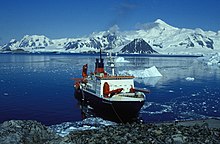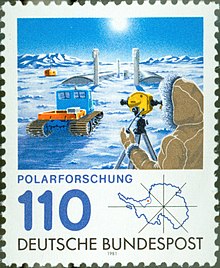Polar research

As polar research scientific is exploring the polar regions Arctic and Antarctic referred.
Research subject and disciplines
18th century
Its beginning can be set at around the 18th century. The main research topics were initially meteorology , geophysics , general geography and oceanography .
In the Arctic, the main focus was initially on the discovery of new land areas or waterways and shorter connections from Europe to Asia . When it became clear that the direct route via the North Pole was not (as initially suspected) free of ice, many expeditions went in search of the Northeast Passage (north of Asia) and the Northwest Passage (north of America). In the south, on the other hand, the focus was on exploring the continent of Antarctica , which was discovered in 1772 .
19th and 20th centuries
At the end of the 19th and beginning of the 20th century, conquering the geographical poles became the main theme. At the same time, the development of comprehensive, interdisciplinary research into the polar regions began with a focus on geophysics , oceanography , glaciology and biology .
present
Since the establishment of governance structures and economic use in the polar regions at the latest , beginning at the end of the 20th century, other disciplines, including legal , political , economic and cultural studies , have increasingly been concerned with research questions relating to polar research.
International research
In the 1870s there was a move towards the internationalization of polar research. The first International Meteorological Congress in Vienna recommended the establishment of meteorological stations in the polar regions in 1873. In a lecture on September 18, 1875 at the 48th meeting of the Society of German Natural Scientists and Doctors in Graz , Carl Weyprecht , who led the Austro-Hungarian North Pole Expedition from 1872-74 together with Julius Payer , presented his basic principles of arctic research . He took the view that “arctic research is of the highest importance for the knowledge of the laws of nature”, but that individual series of observations are only of relative value.
Weyprecht and the presidents of the International Polar Commission founded in 1879, Georg von Neumayer and Heinrich von Wild , succeeded in gaining support from the governments of several European countries and the USA for a joint research project and the establishment of geophysical observation stations. 1882–1883 the first International Polar Year took place with the participation of eleven states with twelve fixed stations in the Arctic and two in the sub-Antarctic . In particular, work in the fields of meteorology and geomagnetism as well as research into the aurora borealis was carried out according to a previously agreed program.
50 years later, the second International Polar Year 1932–1933 was carried out by 15 states with 200 stations in the Arctic alone. This tradition was continued in 1957/58 as part of the International Geophysical Year , which, however, was not limited to the polar regions. The fourth polar year (English: International Polar Year , IPY) took place in 2007–2009 .
Research icebreaker Polarstern
The Polarstern is the only research icebreaker in Germany and with a length of 118 meters it is the largest German research ship in front of the sun , which is 116 meters long. The Polarstern was put into service in 1982 and has been shuttling between the two poles of the earth ever since: In the summer of the northern hemisphere , scientists research the Arctic, in the southern summer the Polarstern sets course for the Antarctic, in addition to the scientific expeditions to take the German research station Neumayer III out of her to supply enormous cargo hold with food, scientific equipment and fuel for the polar planes, helicopters and the operations of the station. Every year in spring and autumn she stops in Bremerhaven on her journey between the poles : In her home port she is made fit for the next voyage, refueled and loaded with scientific equipment and provisions. The icebreaker has a double-walled hull and reinforced steel plates on the bow and on the ice belt, so that it can effortlessly break through ice up to one and a half meters thick. If the ice is thick, the Polarstern rams its way free: During a ram trip, it pushes itself - usually with several attempts at full power (almost 20,000 hp) - onto the ice, which then breaks under the weight of the ship. There are usually two helicopters and rubber dinghies on board, which the scientists can use to take measurements away from the ship. Due to its high weight, the Polarstern has a draft of 11.20 meters.
Permanent stations

The explorations using permanent or operated only in the summer months research stations continues to this day. In the Arctic, ice drift stations also emerged on larger ice floes that drift across the Arctic Ocean for a long time . The joint German-Russian Arctic expedition from 1931, which began with 46 participants on July 24th in Friedrichshafen with the airship " LZ 127 Graf Zeppelin ", after stopovers in Berlin- Staaken and Saint Petersburg via Finland into the northern Barents Sea and was successfully completed on July 30, 1931. As the northernmost point, the last isles of Franz-Josef-Land (the Liv and Eva Islands, which Fridtjof Nansen had reached in 1895 after a week-long ice hike) were crossed. Then, after driving 600 km along the 81st degree of latitude, one reached the northern tip of "Nordland" (Severnaya Zemlya), trying to gain new knowledge about this region from the air, as almost nothing was known about it.
In Germany , polar research has been coordinated by the Alfred Wegener Institute for Polar and Marine Research since 1980 . There is also the German Society for Polar Research , which has been publishing the specialist journal " Polar Research " since 1931 , promoting young scientists and promoting polar research in general.
Scientific collaboration
On the basis of the environmental protection plan for the Arctic, the Arctic Environmental Protection Strategy and a recommendation of the Arctic Council , a university network with a virtual university in the Arctic ( UArctic ) was established in 2001 . This promotes education and interdisciplinary research in the Arctic region. The Bachelor of Circumpolar Studies can be obtained.
Polar research results are also published by the United Nations Environment Program (UNEP) in the United Nations Environment Program-Global Resource Information Database , a worldwide scientific network. The online maps and graphics are particularly noteworthy here.
Comparable research approaches
See also
Web links
- Journal of the German Society for Polar Research
- Alfred Wegener Institute for Polar and Marine Research (AWI)
- Interactive web report about the research icebreaker Polarstern (April 2017)
- International Polar Year 2007/08 (in English)
- International Polar Year 2007/08 (in German)
- The 2nd German north polar voyage in 1869/70
literature
- Hans-Peter Kosack: The polar research. A data book about the natural, cultural and economic conditions and the exploration history of the polar regions. Friedr. Vieweg & Son, Braunschweig 1967
- Klaus Fleischmann: To the cold poles of the earth - 50 years of German polar research. Delius Klasing Verlag, 2005, ISBN 3-7688-1676-1 .
- Dieter Karl Fütterer, Eberhard Fahrbach: POLARSTERN 25 years of research in the Arctic and Antarctic. Delius Klasing Verlag, Bielefeld 2008, ISBN 978-3-7688-2433-0 .
Individual evidence
- ^ Sebastian Leskien: Science as a companion to the implementation of the guidelines of German Arctic policy . Ed .: Polar Research. tape 89 , no. 1 . Copernicus, Bremerhaven, Potsdam, p. 37-45 .
- ↑ C. Lüdecke: 125 years ago - the second international meteorological congress in Rome in 1879. In: DMG-Mitteilungen. 1/2004, pp. 14–16 ( PDF ( Memento of October 12, 2013 in the Internet Archive ); 2.5 MB).
- ↑ Web report: The Polarstern is returning to Bremerhaven , accessed on April 13, 2017.
- ^ University of the Arctic , accessed February 21, 2013.
- ^ Arendal (Norway) UNEP / GRID-Arendal , accessed February 20, 2013.
